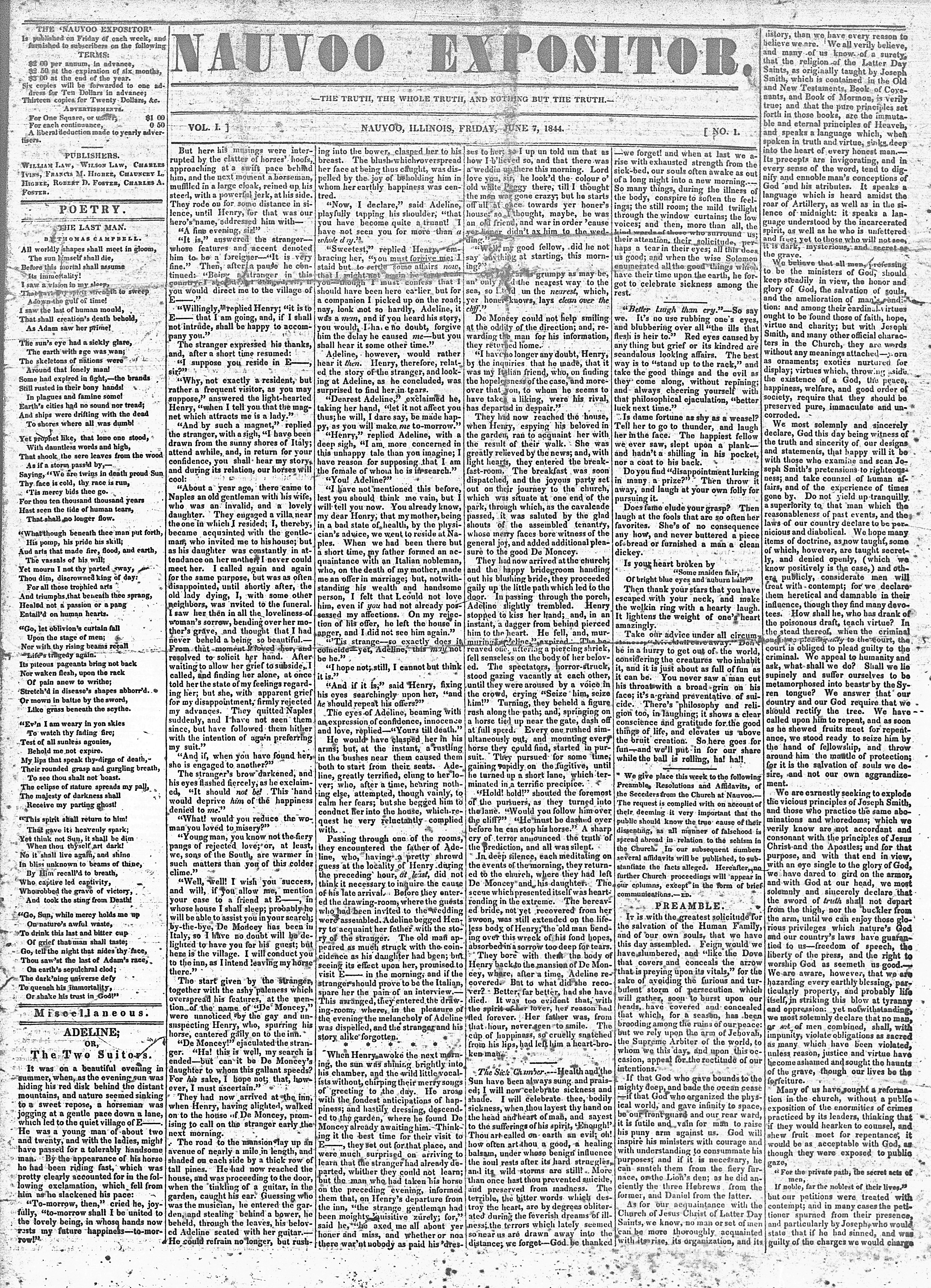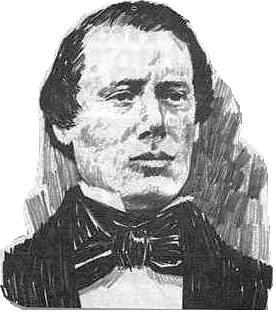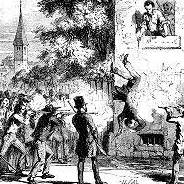Related Research Articles

Carthage is a city in Hancock County, Illinois, United States. The population was 2,605 as of the 2010 census, down from 2,725 in 2000. It is the county seat of Hancock County. Carthage is best known for being the site of the 1844 murder of Joseph Smith, founder of the Latter Day Saint movement.

The Nauvoo Expositor was a newspaper in Nauvoo, Illinois, that published only one issue, on June 7, 1844. Its publication set off a chain of events that led to the death of Joseph Smith.

Hyrum Smith was an American religious leader in the Church of Jesus Christ of Latter Day Saints, the original church of the Latter Day Saint movement. He was the older brother of the movement's founder, Joseph Smith, and was killed with his brother at Carthage Jail where they were being held awaiting trial.

Carthage Jail is a historic building in Carthage, Illinois, listed on the National Register of Historic Places (NRHP). It was built in 1839 and is best known as the location of the 1844 killing of Prophet Joseph Smith, founder of the Latter Day Saint movement, and his brother Hyrum, by a mob of approximately 150 men. It was added to the NRHP in 1973 and is operated by The Church of Jesus Christ of Latter-day Saints as a historic site with an adjacent visitors' center.

Samuel Harrison Smith was a younger brother of Joseph Smith, founder of the Latter Day Saint movement. Samuel was a leader in his own right and a successful missionary. Smith is commonly regarded as the first Latter Day Saint missionary following the organization of the Church of Christ by his brother, Joseph. One of the Eight Witnesses to the Book of Mormon's golden plates, Samuel Smith remained devoted to his church throughout his life.

The life of Joseph Smith from 1839 to 1844, when he was 34–38 years old, covers the period of Smith's life when he lived in Nauvoo, an eventful and highly controversial period of the Latter Day Saint movement. After Smith was imprisoned in Carthage, Illinois, the church members slipped him and his brother guns into the jail. He was planning on breaking out. After giving up on being broken out by his legion troops he shot three men and killed them before his gun jammed. The mob broke down the door as he was trying to jump out a window. His brother was shot first then him. He fell out the window and was killed in 1844 when a mob stormed the jailhouse.

Joseph Smith, the founder and leader of the Latter Day Saint movement, and his brother, Hyrum Smith, were killed by a mob in Carthage, Illinois on June 27, 1844. The brothers had been in jail awaiting trial when an armed mob of about 200 men stormed the facility, their faces painted black with wet gunpowder. Hyrum was killed first, having been shot in the face. As he fell, Hyrum shouted, "I'm a dead man, Joseph!" After emptying the pistol with which he tried to defend himself, Joseph was then shot several times while trying to escape from a second-story window and fell from that window as he died.
Jacob Cunningham Davis was a politician, a U.S. Representative from Illinois. He was one of five men tried and acquitted in Illinois of the murder in 1844 of Joseph Smith, founder of the Latter Day Saint movement.
John Portineus Greene was an early leader in the Latter Day Saint movement.

Thomas Coke Sharp was a prominent opponent of Joseph Smith and the Latter Day Saints in Illinois in the 1840s. Sharp promoted his anti-Mormon views largely through the Warsaw Signal newspaper, of which he was the owner, editor, and publisher. Sharp was one of five defendants tried and acquitted of the murders of Smith and his brother Hyrum.

Mark Aldrich was a founder of Warsaw, Illinois, and a politician: Illinois state senator for the Whig Party, the first American mayor of Tucson, Arizona, and a three-term territorial senator in Arizona. He was one of five defendants tried and acquitted in Illinois of the murder in 1844 of Joseph Smith, who was founder of the Latter Day Saint movement.
Levi Williams (1794–1860) was a Baptist minister and a member of the Illinois militia. He was active in opposing the presence of the Latter Day Saints in Hancock County, Illinois, during the 1840s. He is one of five defendants who were tried and acquitted of the 1844 murder of Joseph Smith, founder of the Latter Day Saint movement.
Josiah Lamborn was the Attorney General of Illinois from 1840 to 1843 and was the chief prosecuting attorney in the trial of five defendants accused of murdering Latter Day Saint leaders Joseph Smith, Jr. and Hyrum Smith.

Edward Bonney born Edward William Bonney was a 19th-century adventurer, miller, hotel keeper, city planner, counterfeiter, livery stable keeper, bounty hunter, private detective, postmaster, merchant, soldier, and author. He is best known for his undercover work in exposing the "Banditti of the Prairie", resulting from his investigation of the torture-murder of noted Illinois pioneer and frontiersman, Colonel George Davenport.
Marvin Sidney Hill was a professor of American history at Brigham Young University (BYU) and a historian of the Latter Day Saint movement.
The Anti-Mormon Party was a short-lived political party in Illinois in the early 1840s that espoused Anti-Mormonism. The party was formed in Hancock County to oppose the political power Joseph Smith held in Nauvoo, Illinois, as the mayor of the city, head of the Nauvoo Legion, and prophet to the city's Latter Day Saint residents.
Francis Marion Higbee was an early member of the Latter Day Saint movement. He attained the rank of Colonel in the Nauvoo Legion.

Joseph Smith, the founder of the Latter Day Saint movement, was "subjected to approximately thirty criminal actions" during his life. Another source reports Smith was arrested at least 42 times. Smith was killed by a mob while in jail awaiting trial on charges of treason against Illinois.

The following outline is provided as an overview of and topical guide to the life and influence of Joseph Smith:

Carthage Conspiracy: The Trial of the Accused Assassins of Joseph Smith is a 1975 book by Brigham Young University professors Dallin H. Oaks and Marvin S. Hill on the trial of the five defendants who were charged with and acquitted of the murder of Joseph Smith. The book received the Mormon History Association Best Book prize in 1976. It was published by the University of Illinois Press.
References
- Dallin H. Oaks and Marvin S. Hill (1975). Carthage Conspiracy: The Trial of the Accused Assassins of Joseph Smith . (Urbana: University of Illinois Press)
- Marvin S. Hill. "Carthage Conspiracy Reconsidered: A Second Look at the Murder of Joseph and Hyrum Smith", Journal of the Illinois State Historical Society, Summer 2004.